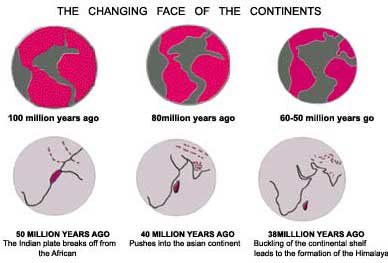Continental drift
 Earthquakes occur due to inter-continental collision, and also due to intra-continental rupture of rock plates. About a dozen continental plates float on the Earth's semi liquid crust, just like the floating islands in Manipur's Loktak lake. The Indian plate collided with the Asian one some 38 million years ago forming the Himalaya, and since then has been barging into the Asian plate resulting in earthquakes.
Earthquakes occur due to inter-continental collision, and also due to intra-continental rupture of rock plates. About a dozen continental plates float on the Earth's semi liquid crust, just like the floating islands in Manipur's Loktak lake. The Indian plate collided with the Asian one some 38 million years ago forming the Himalaya, and since then has been barging into the Asian plate resulting in earthquakes.
As the whole Indian plate plows into the Asian plate, it creates enormous elastic strain energy that is released as earthquakes. This movement at a rate of 5 centimetres per year has also caused intra-plate faults due to strain in rock mass. When these fault lines rupture earthquakes happen. Bhuj was such an earthquake.
Some 100 million years ago, all the continents were together known as Gondwanaland with a radius two-thirds of its present length. The Indian sub-continent broke away from the southern part of Gondwanaland to start its 60 million years northward journey till it collided with the Asian plate. The Himalaya are one of the world's most seismic zones and have reported most of the devastating earthquakes.
